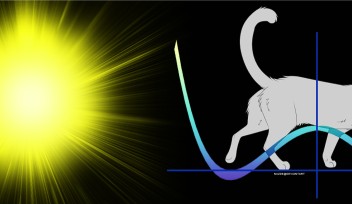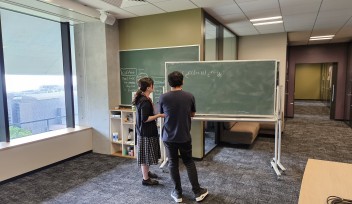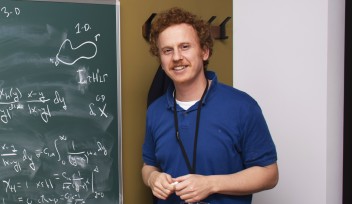To Bend Without Breaking

A topologist can’t tell the difference between a doughnut and a coffee mug – this is a well-worn joke in topology, a field of mathematics concerned with properties of geometric shapes which are preserved when the shapes are bent, stretched, or otherwise deformed. A mug and a doughnut made of clay could, in fact, be squished and twisted into likenesses of one another, explained Professor Dmitry Feichtner-Kozlov, the head of the Applied Topology Unit at the Okinawa Institute of Science and Technology Graduate University (OIST).
Though classical topology is concerned with bending and stretching spaces, recent years have seen paradigm shifts in the field. This is, in part, due to Feichtner-Kozlov’s work. He finds topology in unexpected places, such as theory of computation, or even graph colorings – labeling elements of graphs under certain constraints. His interdisciplinary work continues to reinvigorate this central mathematical discipline.
Topology, like many other fields, seeks to identify fundamental characteristics of an object that make it different from another object, Feichtner-Kozlov explained.
“In topology, unlike some branches of mathematics, we don’t care about curvature or angles; we only care about whether one shape can be transformed into another one without tearing a hole into it,” he said.
To classify geometric spaces, Feichtner-Kozlov seeks out invariants — rules that hold for any two equivalent shapes. For example, the doughnut and the coffee mug each have one hole and can be continuously transformed into one another. Having one hole is an example of invariant.
A hollow doughnut shape and a sphere, on the other hand, are not equivalent in topology, since the doughnut has a hole, while the sphere lacks one.
Topologists can then use invariants to study more complicated spaces based on their understandings of smaller, ‘local” structures.
A self-motivated mathematician
Feichtner-Kozlov knew he wanted to be a mathematician by the time he was twelve or thirteen years old, growing up in the Soviet Union. Persistent and self-motivated, he mostly taught himself math throughout his adolescence. Years later, he earned his PhD in mathematics from the Royal Institute of Technology in Stockholm, Sweden. Now, he serves as the chair of Algebra and Geometry at the University of Bremen in Germany and holds an adjunct professorship at OIST, studying applied algebraic topology.
Although mathematics can be abstract, Feichtner-Kozlov is attracted to unveiling the truths the field holds.
“There’s a sense of correctness, of objectivity in mathematics that other disciplines lack,” he said. “Doing math isn’t a matter of forming opinions; it’s about pursuing correct, but also relevant arguments.”

From the local to the global
When applying topology to data analysis, rather than making measurements of their own, topologists mostly analyze very large datasets from many different fields, ranging from computer science to medicine. They take these datasets and convert them into geometric shapes, gleaning valuable information about essential features of the data and allowing it to be sorted into groups.
Feichtner-Kozlov recently published an article on homology cycles, one such tool for simplifying complicated datasets. Homology is a mathematical concept that associates topological spaces with invariants, allowing mathematicians to distinguish between spaces and properly classify them. These homology cycles have applications in data processing and computation.
"Homology cycles can be thought of as small shapes inside of spaces,” Feichtner-Kozlov explained. “Each of these shapes highlights a certain geometric feature.” By first understanding the specific features of large, complicated shapes, topologists can better understand the larger shape.
Feichtner-Kozlov is developing a novel algorithm to find these homology cycles; the algorithm follows invariants to keep track of essential features of a space as its complexity is reduced.
New frontiers of topology
Feichtner-Kozlov’s work is progressing the field, particularly in the area of graph coloring, a well-studied concept in mathematics.
"It’s incredibly difficult to show that a graph cannot be colored with a fixed number of colors, so that any two parts connected by an edge are different colors,” he said. “This is because the number of coloring possibilities is enormous even for reasonably small graphs, making a direct computer check impossible.”
He discovered a new, indirect way to produce estimates about these graphs. In his work he has noticed that sophisticated topological invariants, known as Stiefel-Whitney characteristic classes, may hold the key to these graph colorings.
This type of unorthodox and interdisciplinary thinking is shifting the field from simpler, combinatorial problems to more advanced frontiers of algebraic and applied topology. At OIST, he hopes to continue developing formal topological theory, while also bringing it to life in new ways outside of the field.
Specialties
For press enquiries:
Press Inquiry Form














